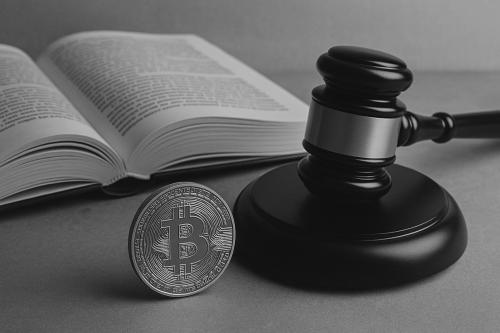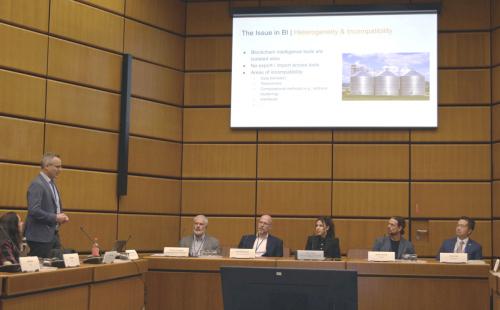Crypto: the ultimate enabler of corruption?

As cryptoassets and other blockchain-based tokens enter the mainstream, alarm bells are ringing about the risks of their misuse. The technology is neutral in itself, but like any mechanism to transfer value, it can and does facilitate a wide range of crimes.
And it’s not just scams, hacks and ransomware attacks. Cryptoassets are now seen in practically all crime types, from drug trafficking and terrorist financing to sanctions evasion, and increasingly as a tool for laundering the proceeds of those crimes.
When it comes to the links between crypto and corruption, research and closed case examples are still scant. But since both are important enablers of crime, it’s vital to better understand how they intersect.
This blog outlines some basic areas of concern. Despite the gaps in data and analysis, one thing is clear. While the technologies are fairly new, the corrupt practices are not: they are simply manifesting in different ways.
Crypto and corruption: what we mean
In this blog we take a broad view of both crypto and corruption. By “crypto”, we mean cryptoassets such as Bitcoin (BTC) and Ether (ETH) as well as stablecoins tied to fiat currencies such as Tether (USDT) and USD Coin (USDC); plus other digital tokens that run on public, decentralised blockchains. The scope also includes the companies, industries and services built around crypto, as well as the systems for their regulation and supervision and for law enforcement. “Corruption” refers not just to bribery, but to any abuse of entrusted power for undue benefit – whether financial or political, whether personal or for a collective entity.
1 Crypto for bribery
Is crypto a brilliant way to pay bribes and kickbacks? Transfers are pseudonymous after all – linked to long wallet addresses like 1Lbcfr2sAHTG9CgdQo3HTMTkV7LK4ZnX75 rather than names. Transfers can be made directly between individuals, through decentralised platforms or peer-to-peer transactions, which avoids awkward questions about who is who and where the money comes from.
Crypto holdings are easier to keep private, so might not be included in the asset declarations of politically exposed persons keen not to reveal all of their hidden wealth. And it’s fast and easy: you can transfer crypto to any person, anywhere in the world at the touch of a button. That makes it superficially more attractive than an international bank transfer, and less hassle and personal risk than travelling to another continent carrying suitcases stuffed with cash.
Some clearly think crypto is great for bribes:
- In 2024, a Ukrainian Member of Parliament was sentenced to eight years in prison for offering a bribe of EUR 46,000 in bitcoin to secure funding for reconstruction projects.
- Crypto payments were allegedly made to a former senior official at the China Securities Regulatory Commission in return for abuses of power in making appointments and securing loans – alongside expensive liquor and invitations to banquets.
- In June 2025, two employees of the state-owned China Construction Bank were charged in Hong Kong with bribery and other offences: they allegedly accepted around USD 470,000 in crypto in exchange for authenticating false documents for the now-bankrupt Israeli firm Vesttoo.
Yet the use of crypto for bribery has a unique vulnerability: transactions on public blockchains are permanent and publicly visible. If investigators can verifiably link an address to a suspect, the evidence of the bribery remains accessible forever.
Sadly, it’s pretty hard to identify bribes or kickbacks being paid unless you already know there’s a bribery scheme or you know the addresses of suspected accomplices. That might explain why major crypto bribery cases haven’t surfaced (yet!).
2 Laundering proceeds of corruption using crypto
What about laundering the proceeds of corruption? For those with a lot of dirty money to launder, crypto adds a new dimension to the playbook.
Sure, keep the shell companies and offshore bank accounts, the trusts and real estate and gambling schemes, the hawala networks. Now you can add to the mix by converting corrupt proceeds into crypto, converting these to other coins, hopping across blockchains and using privacy-enhancing technologies to throw investigators off track.
As adoption of tokenised assets grows – digital representations of financial or real-world assets – we can expect corrupt actors to buy not only villas in Tuscany and ski apartments in Switzerland, but tokens representing these. And while you can’t ski on a digital token, it is likely attractive to money launderers to be able to trade in a broad range of investments while keeping the beneficial owner hidden.
Are corrupt actors using crypto to launder their funds? There’s little direct evidence, but it does seem likely. Corrupt individuals have long relied on professional money laundering services, often provided by lawyers and accountants. Europol warns that these professionals,
“increasingly with specialised knowledge in digital asset trading, have developed parallel, underground financial systems that operate outside the regulatory frameworks governing legal financial institutions”.
And we do see that law enforcement is starting to take down organised groups that specialise in laundering illicit funds, including through crypto.
An Australian takedown of an organised money laundering operation in June 2025, for example points to millions of tainted Australian dollars laundered through crypto exchanges as well as bank accounts, couriers, a car dealership and a sales company. Some outfits specialise in a specific clientele: in the Europol-coordinated Operation Karasu in 2025, authorities arrested 17 suspects alleged to be providing money laundering services to Chinese- and Arabic-speaking clients using hawala banking, cash transactions and crypto.
The largest blockbuster takedown to date is the October 2025 indictment of the Chairman of Prince Group, a Cambodia-based multinational business enterprise, and the filing of a forfeiture action for more than 127,000 bitcoin – approximately USD 15 billion at the time of seizure. The press release described the use of professional money laundering operations and pointed to highly sophisticated techniques, such as “spraying” stolen cryptoassets across multiple addresses to obscure the trail of the funds.
Commenting on the indictment, the head of the U.S. Drug Enforcement Administration highlighted the role of corruption in such schemes. He explained how:
“complex criminal schemes [such as this] exploit global financial systems and emerging technologies to conceal illicit proceeds. These networks operate at the intersection of drug trafficking, corruption, and financial crime, threatening the stability of institutions and communities, alike.”
3 Corrupt law enforcement in crypto cases
Say you’re a law enforcement officer – a public servant. You’re one of the few in your agency with the technical skills to trace and seize cryptoassets suspected of being involved in crime.
You see an opportunity to supplement your salary by stealing crypto during an investigation or taking payments from criminals to leave their holdings in peace. Nobody will know – surely?
- That’s what two US agents from the Drug Enforcement Administration and Secret Service thought, when they abused their power as law enforcement officers and their access to government-controlled wallets to steal tens of millions of USD in bitcoin linked to the takedown of the illicit Silk Road online marketplace.
- In Russia, a former investigator was found guilty in 2023 of accepting bitcoin bribes equivalent to tens of millions of US dollars from an organised crime group in order not to confiscate their bitcoin holdings – estimated at USD 138 million at the time.
- In Iran, senior intelligence officers of the Revolutionary Guard are alleged to have gained around USD 21 million during the takedown of the Cryptoland exchange: following the CEO’s arrest, they stole and sold his tokens before the arrest was made public and the tokens’ value collapsed.
It’s not uncommon for law enforcement officers to go rogue, or for bribes to be paid to influence law enforcement actions or judicial proceedings. So authorities don’t just need to build capacity to go after crypto-related crime. They also need to look out for crypto-related corruption risks among their own ranks, including entities such as asset management offices that have custody over seized and confiscated cryptoassets.
4 When the crypto industry meets politics
Crypto is a fast-evolving industry that demonstrates genuinely exciting financial and technological innovation. It’s no wonder that politicians all over the world are getting interested.
Corrupt behaviour by politicians involving the crypto industry is still a realm of speculation, as data on real-world cases is sparse. But red flags for corruption are a common feature of all fast-growing, profitable industries with highly technical aspects, like mining and defence. So, it is sensible to look out for common risks, which span from licencing schemes to the shaping of cryptoasset regulations or the resources put into enforcement.
When it comes to public trust in government, even suspicions of crypto-related wrongdoing matter. Examples range from a political financing scandal in Colombia to graft accusations in Venezuela and to allegations of crypto-related irregularity affecting the US President and his family.
And in the Czech Republic, when the Justice Ministry accepted a bitcoin donation worth around USD 46 million from a convicted criminal, the ensuing scandal triggered a public investigation and the resignation of the Justice Minister; some feared it might even topple the government.
5 Corruption fuelling organised crime and state capture
The link between crypto and corruption with possibly the most damaging social impact is its role in enabling criminal gangs to carry out cybercrime and launder money with impunity.
As detailed in a 2025 UNODC report on corruption and cybercrime, corruption both creates the “permissive environment” that allow cybercrime operations to flourish and “enables many daily operations of cybercriminal networks.”
In Southeast Asia, for example, a separate UNODC report depicts how industrial-scale scam centres run by organised crime groups generate huge amounts of illegal revenue – mostly in crypto. Despite often being plainly identified in public reports, they remain operational and engage in human trafficking to obtain unwilling workers. The report emphasises “high rates of corruption which criminal actors can leverage” to continue their scam operations unmolested.
UNODC warns that the revenue generated by scam centres, coupled with the ability to easily launder the stolen crypto, is increasing the power and influence of organised crime groups as well as their financial liquidity. And that gives them even more ability to corrupt and capture politicians and states.
That may already be happening, according to a November 2025 Economist report on allegations of political collusion in scam operations in Cambodia, the Philippines and Thailand. These have led to the resignation of a deputy finance minister, the jailing of a mayor and a warning from Thailand's deputy leader of the opposition that without action against politicians colluding in scam operations,
“we’ll wake up to find the country run by crooks in suits".
What to do?
Crypto represents an exciting transformation in financial systems. The industry and its underlying technology could improve privacy, efficiency and access to financial markets. This may benefit many people poorly served by today’s centralised systems.
But without a clear understanding of crypto-related risks and proper safeguards, the industry could create more opportunities for corruption and related financial crimes such as money laundering, terrorist financing and sanctions evasion. Crypto-fuelled corruption could weaken trust in governments and be leveraged to undermine the stability and security of nation states.
At the Basel Institute, we’re keen to explore better how the worlds of crypto and corruption intersect and how best to mitigate both systemic and day-to-day risks. We’re also committed to building the capacity of anti-corruption and asset recovery practitioners to “follow the money” across blockchains and to connect these to wider financial and criminal investigations.
Beyond training for individuals and public agencies, we also bring together people from across sectors and geographies at our annual Global Conference on Criminal Finances and Cryptoassets together with Europol and UNODC. Look out for more on this topic in the coming months!





